SpringSecurity整合SpringBoot集中式版
初步整合
首先创建springboot项目,并确保能够启动
编写一个处理器用于测试
import org.springframework.stereotype.Controller;
import org.springframework.web.bind.annotation.RequestMapping;
import org.springframework.web.bind.annotation.ResponseBody;
@Controller
@RequestMapping("/product")
public class ProductController {
@RequestMapping
@ResponseBody
public String hello() {
return "success";
}
}
启动项目,访问对应的地址:

测试成功
加入SpringSecurity的依赖
在SpringBoot中使用SpringSecurity不再像在Spring中那么麻烦,并不需要配置文件,只需要导入SpringSecurity的依赖即可
<dependency>
<groupId>org.springframework.boot</groupId>
<artifactId>spring-boot-starter-security</artifactId>
</dependency>
导入后重启,再次访问就需要进行认证了,这表明SpringSecurity已经生效了
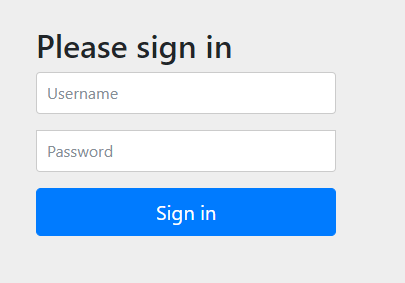
那么问题来了!此刻并没有连接数据库,也并未在内存中指定认证用户,如何认证呢?
其实SpringBoot已经提供了默认用户名user,密码在项目启动时随机生成,如图:

复制随机生成的密码,使用user用户名登录即可

加入jsp页面
SpringBoot官方是不推荐在SpringBoot中使用jsp的,那么到底可以使用吗?答案是肯定的!
不过需要导入tomcat插件启动项目,不能再用SpringBoot默认tomcat了。
导入SpringBoot的tomcat启动插件依赖
<dependency>
<groupId>org.springframework.boot</groupId>
<artifactId>spring-boot-starter-tomcat</artifactId>
</dependency>
<dependency>
<groupId>org.apache.tomcat.embed</groupId>
<artifactId>tomcat-embed-jasper</artifactId>
</dependency>
加入jsp页面等静态资源
想要加入jsp页面,第一个需要解决的问题就是jsp页面放在哪儿?以前的resources是不能够再用来放jsp页面,因此需要再src/main下面创建webapp目录
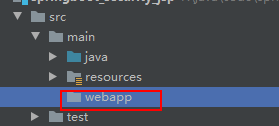
这时webapp目录并不能正常使用,因为只有web工程才有webapp目录,在pom文件中修改项目为web工程

这时webapp目录,可以正常使用了!再导入自定义的jsp页面即可
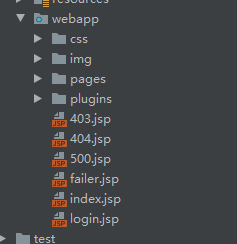
修改相应的登录和退出地址


提供SpringSecurity配置类
以前想要SpringSecurity识别自己的登录页面需要去配置文件中配置,但是在SpringBoot这些配置都以配置类的形式存在,因此只需要创建配置类配置即可
import org.springframework.context.annotation.Configuration;
import org.springframework.security.config.annotation.authentication.builders.AuthenticationManagerBuilder;
import org.springframework.security.config.annotation.web.builders.HttpSecurity;
import org.springframework.security.config.annotation.web.configuration.EnableWebSecurity;
import org.springframework.security.config.annotation.web.configuration.WebSecurityConfigurerAdapter;
@Configuration
@EnableWebSecurity
public class SecurityConfig extends WebSecurityConfigurerAdapter {
// 认证用户的来源【内存或者数据库】
@Override
public void configure(AuthenticationManagerBuilder auth) throws Exception {
auth.inMemoryAuthentication()
.withUser("user")
.password("{noop}123")
.roles("USER");
}
// 配置SpringSecurity相关信息
@Override
public void configure(HttpSecurity http) throws Exception {
// 释放静态资源 指定资源拦截规则 指定自定义认证页面 指定退出认证配置 csrf配置
http.authorizeRequests()
.antMatchers("/login.jsp", "/failer.jsp", "/css/**", "/img/**", "/plugins/**").permitAll()
.antMatchers("/**").hasAnyRole("USER", "ADMIN") // 表示访问所有的页面都要USER或者ADMIN角色
.anyRequest()
.authenticated() // 表明其他的资源只有通过认证后才能访问
.and() // 表示一个新的配置开始
.formLogin()
.loginPage("/login.jsp")
.loginProcessingUrl("/login") // 认证处理器
.successForwardUrl("/index.jsp")
.failureForwardUrl("/failer.jsp")
.permitAll() // 释放上面所有的资源,例如/login是需要释放的
.and()
.logout()
.logoutUrl("/logout")
.logoutSuccessUrl("/login.jsp")
.invalidateHttpSession(true) // 是否清空session
.permitAll()
.and()
.csrf()
.disable(); // 禁用csrf
}
}
修改控制器
现在有了页面,就跳转到一个页面吧
@RequestMapping("/findAll")
public String findAll() {
return "product-list";
}
配置视图解析器
我们需要指定前后缀,去application.yml中即可
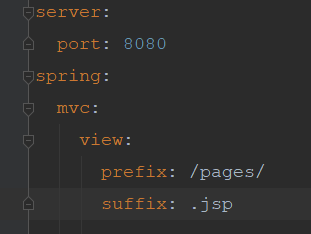
使用tomcat插件启动项目
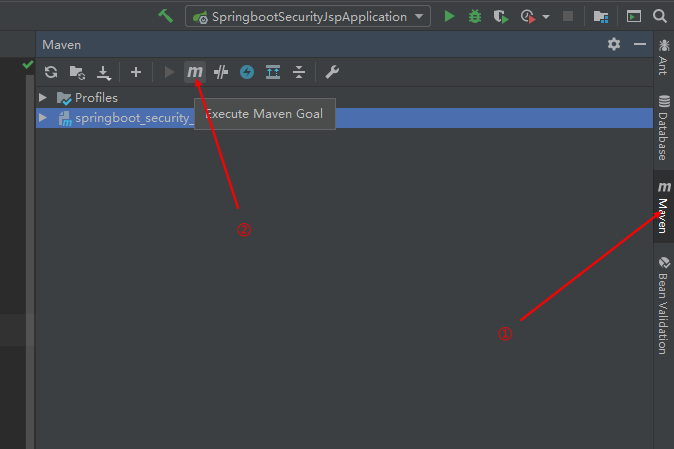
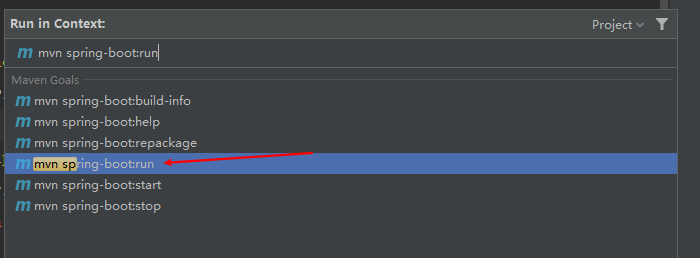
通过上面的方式启动页面。
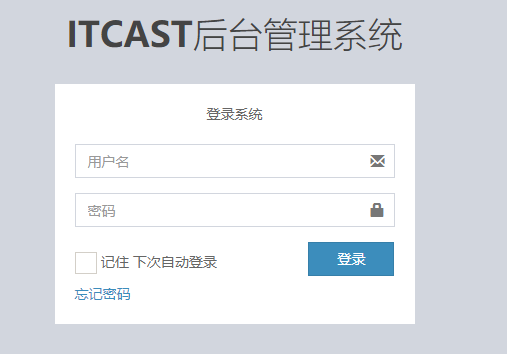
此时可以看到,SpringSecurity已经开始使用我们自己的页面了。
加入数据库
数据库文件在[]: https://www.cnblogs.com/Myarticles/articles/12795346.html
导入相关包
<dependency>
<groupId>mysql</groupId>
<artifactId>mysql-connector-java</artifactId>
<version>5.1.47</version>
</dependency>
<dependency>
<groupId>tk.mybatis</groupId>
<artifactId>mapper-spring-boot-starter</artifactId>
<version>2.1.5</version>
</dependency>
在配置文件中添加数据库操作相关配置
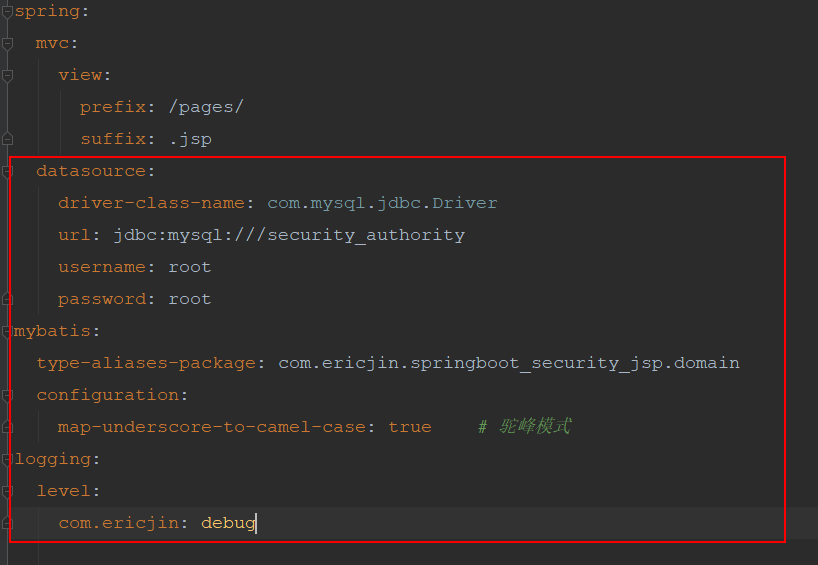
在启动类上添加扫描mapper接口包注解

创建pojo对象
用户
import com.fasterxml.jackson.annotation.JsonIgnore;
import lombok.Data;
import org.springframework.security.core.GrantedAuthority;
import org.springframework.security.core.userdetails.UserDetails;
import java.util.Collection;
import java.util.List;
@Data
public class SysUser implements UserDetails {
private Integer id;
private String username;
private String password;
private Integer status;
private List<SysRole> roles;
@JsonIgnore // 标记此属性不做json处理
@Override
public Collection<? extends GrantedAuthority> getAuthorities() {
return roles;
}
@Override
public String getPassword() {
return password;
}
@Override
public String getUsername() {
return username;
}
@JsonIgnore // 标记此属性不做json处理
@Override
public boolean isAccountNonExpired() {
return true;
}
@JsonIgnore // 标记此属性不做json处理
@Override
public boolean isAccountNonLocked() {
return true;
}
@JsonIgnore // 标记此属性不做json处理
@Override
public boolean isCredentialsNonExpired() {
return true;
}
@JsonIgnore // 标记此属性不做json处理
@Override
public boolean isEnabled() {
return true;
}
}
角色
import com.fasterxml.jackson.annotation.JsonIgnore;
import lombok.Data;
import org.springframework.security.core.GrantedAuthority;
@Data
public class SysRole implements GrantedAuthority {
private Integer id;
private String roleName;
private String roleDesc;
@JsonIgnore // 标记此属性不做json处理
@Override
public String getAuthority() {
return roleName;
}
}
提供mapper接口
用户
import com.ericjin.springboot_security_jsp.domain.SysUser;
import org.apache.ibatis.annotations.Many;
import org.apache.ibatis.annotations.Result;
import org.apache.ibatis.annotations.Results;
import org.apache.ibatis.annotations.Select;
import tk.mybatis.mapper.common.Mapper;
import java.util.List;
public interface UserMapper extends Mapper<SysUser> {
@Select("select * from sys_user where username = #{username}")
@Results({
@Result(id = true, property = "id", column = "id"),
@Result(property = "roles", column = "id", javaType = List.class,
many = @Many(select = "com.ericjin.springboot_security_jsp.mapper.RoleMapper.findByUserId"))
})
SysUser findByName(String username);
}
角色
import com.ericjin.springboot_security_jsp.domain.SysRole;
import org.apache.ibatis.annotations.Select;
import tk.mybatis.mapper.common.Mapper;
import java.util.List;
public interface RoleMapper extends Mapper<SysRole> {
@Select("SELECT r.id, r.role_name roleName, r.role_desc roleDesc " +
"FROM sys_role r, sys_user_role ur " +
"WHERE r.id = ur.rid AND ur.uid = #{uid}")
List<SysRole> findByUserId(Integer uid);
}
提供认证service接口
import org.springframework.security.core.userdetails.UserDetailsService;
public interface UserService extends UserDetailsService {
}
提供认证service实现类
import com.ericjin.springboot_security_jsp.mapper.UserMapper;
import com.ericjin.springboot_security_jsp.service.UserService;
import org.springframework.beans.factory.annotation.Autowired;
import org.springframework.security.core.userdetails.UserDetails;
import org.springframework.security.core.userdetails.UsernameNotFoundException;
import org.springframework.stereotype.Service;
import org.springframework.transaction.annotation.Transactional;
@Service
@Transactional
public class UserServiceImpl implements UserService {
@Autowired
private UserMapper userMapper;
@Override
public UserDetails loadUserByUsername(String s) throws UsernameNotFoundException {
return userMapper.findByName(s);
}
}
修改配置类
@Configuration
@EnableWebSecurity
public class SecurityConfig extends WebSecurityConfigurerAdapter {
@Autowired
private UserService userService;
/**
* 把加密对象放入IOC容器中
* @return
*/
@Bean
public BCryptPasswordEncoder passwordEncoder() {
return new BCryptPasswordEncoder();
}
// 认证用户的来源【内存或者数据库】
@Override
public void configure(AuthenticationManagerBuilder auth) throws Exception {
auth.userDetailsService(userService).passwordEncoder(passwordEncoder());
}
}
使用mvn springboot:run的方式启动项目即可。
此时,整个项目就使用了数据库进行认证!
实现授权功能
在配置类上添加开启方法级的授权注解
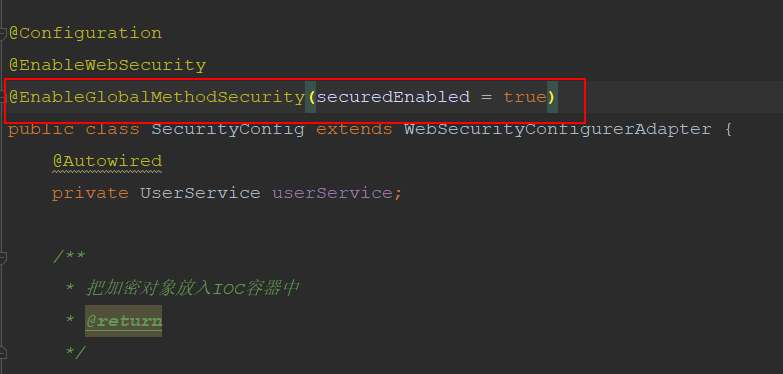
在产品处理器类上添加注解
要求访问该方法必须拥有ROLE_PRODUCT角色
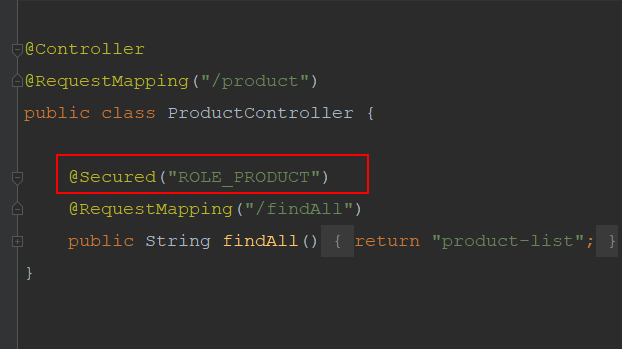
重启测试
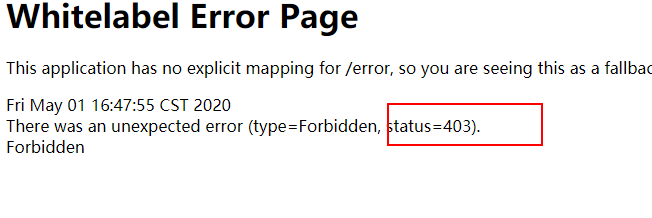
显示403没有权限
指定自定义异常页面
import org.springframework.security.access.AccessDeniedException;
import org.springframework.web.bind.annotation.ControllerAdvice;
import org.springframework.web.bind.annotation.ExceptionHandler;
@ControllerAdvice
public class HandlerControllerException {
@ExceptionHandler(AccessDeniedException.class)
public String handlerException403() {
return "forward:/403.jsp";
}
@ExceptionHandler(RuntimeException.class)
public String otherException() {
return "forward:/500.jsp";
}
}
再次测试就可以看到自定义异常页面了

到此,集中式环境中的整合就完成了!







 浙公网安备 33010602011771号
浙公网安备 33010602011771号